PICT110 - How Serious are Cyber Security Attacks? A Security Study
VerifiedAdded on 2023/06/11
|13
|3593
|224
Essay
AI Summary
This essay explores the severity of cybersecurity attacks, emphasizing their potential impact on various sectors, including industrial equipment, financial systems, consumer devices, aviation, and large corporations. It discusses how cyber threats have evolved from simple hacking to sophisticated attacks like Stuxnet, NotPetya, and WannaCry, which can disrupt critical infrastructure and compromise sensitive data. The essay also addresses the multi-dimensional nature of cyber threats, distinguishing between internal and external attacks, as well as syntactic and semantic threats. It highlights the increasing reliance on computer systems and the internet, making societies more vulnerable to cyberattacks with political or financial motivations. Concluding with the importance of prevention and control measures to mitigate these risks.

qwertyuiopasdfghjklzxcvbnmqwertyui
opasdfghjklzxcvbnmqwertyuiopasdfgh
jklzxcvbnmqwertyuiopasdfghjklzxcvb
nmqwertyuiopasdfghjklzxcvbnmqwer
tyuiopasdfghjklzxcvbnmqwertyuiopas
dfghjklzxcvbnmqwertyuiopasdfghjklzx
cvbnmqwertyuiopasdfghjklzxcvbnmq
wertyuiopasdfghjklzxcvbnmqwertyuio
pasdfghjklzxcvbnmqwertyuiopasdfghj
klzxcvbnmqwertyuiopasdfghjklzxcvbn
mqwertyuiopasdfghjklzxcvbnmqwerty
uiopasdfghjklzxcvbnmqwertyuiopasdf
ghjklzxcvbnmqwertyuiopasdfghjklzxc
vbnmqwertyuiopasdfghjklzxcvbnmrty
uiopasdfghjklzxcvbnmqwertyuiopasdf
ghjklzxcvbnmqwertyuiopasdfghjklzxc
vbnmqwertyuiopasdfghjklzxcvbnmqw
HOW SERIOUS ARE CYBER SECURITY ATTACKS
SECURITY STUDIES
6/3/2018
opasdfghjklzxcvbnmqwertyuiopasdfgh
jklzxcvbnmqwertyuiopasdfghjklzxcvb
nmqwertyuiopasdfghjklzxcvbnmqwer
tyuiopasdfghjklzxcvbnmqwertyuiopas
dfghjklzxcvbnmqwertyuiopasdfghjklzx
cvbnmqwertyuiopasdfghjklzxcvbnmq
wertyuiopasdfghjklzxcvbnmqwertyuio
pasdfghjklzxcvbnmqwertyuiopasdfghj
klzxcvbnmqwertyuiopasdfghjklzxcvbn
mqwertyuiopasdfghjklzxcvbnmqwerty
uiopasdfghjklzxcvbnmqwertyuiopasdf
ghjklzxcvbnmqwertyuiopasdfghjklzxc
vbnmqwertyuiopasdfghjklzxcvbnmrty
uiopasdfghjklzxcvbnmqwertyuiopasdf
ghjklzxcvbnmqwertyuiopasdfghjklzxc
vbnmqwertyuiopasdfghjklzxcvbnmqw
HOW SERIOUS ARE CYBER SECURITY ATTACKS
SECURITY STUDIES
6/3/2018
Paraphrase This Document
Need a fresh take? Get an instant paraphrase of this document with our AI Paraphraser
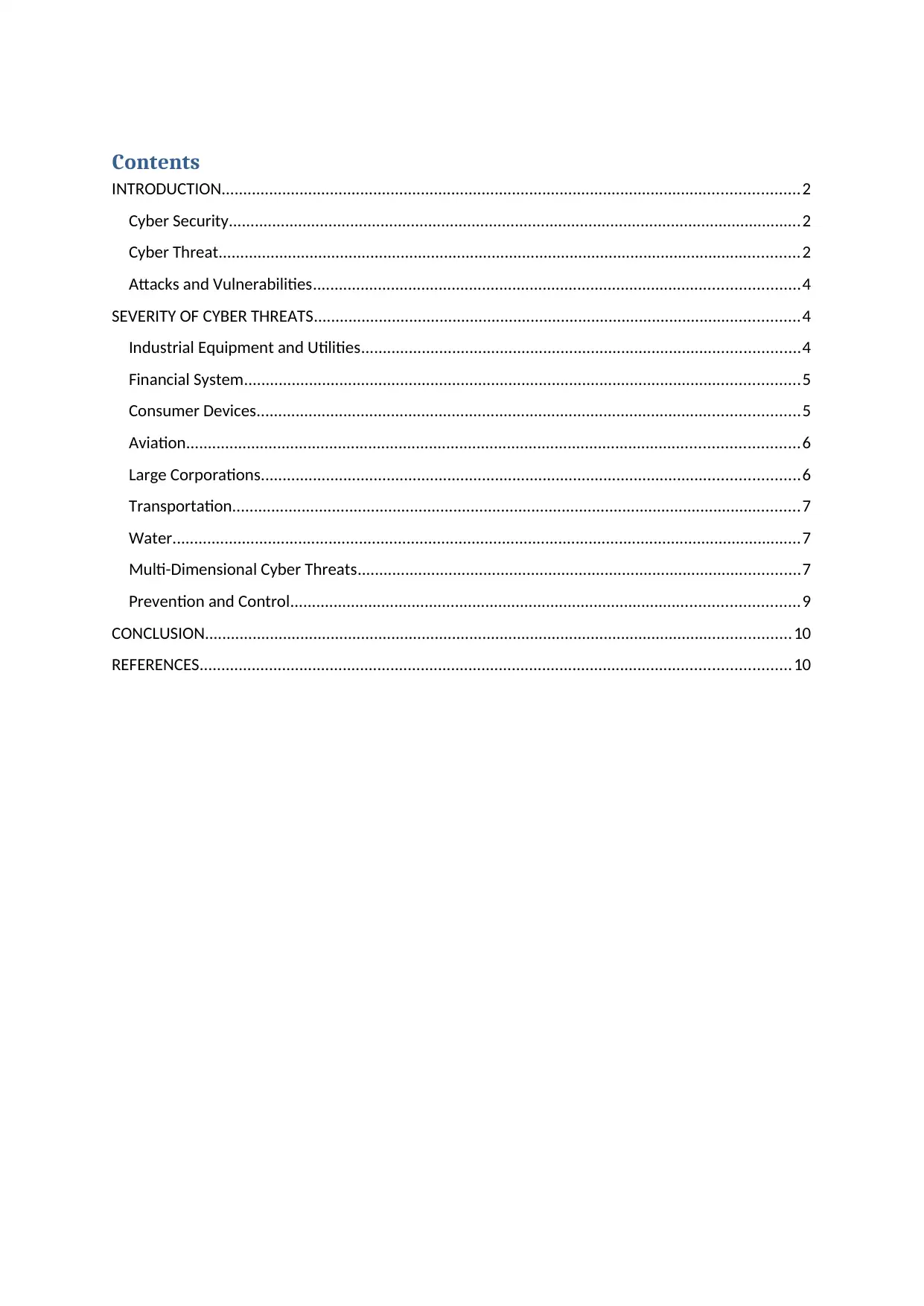
Contents
INTRODUCTION.....................................................................................................................................2
Cyber Security....................................................................................................................................2
Cyber Threat......................................................................................................................................2
Attacks and Vulnerabilities................................................................................................................4
SEVERITY OF CYBER THREATS................................................................................................................4
Industrial Equipment and Utilities.....................................................................................................4
Financial System................................................................................................................................5
Consumer Devices.............................................................................................................................5
Aviation.............................................................................................................................................6
Large Corporations............................................................................................................................6
Transportation...................................................................................................................................7
Water.................................................................................................................................................7
Multi-Dimensional Cyber Threats......................................................................................................7
Prevention and Control.....................................................................................................................9
CONCLUSION.......................................................................................................................................10
REFERENCES........................................................................................................................................10
INTRODUCTION.....................................................................................................................................2
Cyber Security....................................................................................................................................2
Cyber Threat......................................................................................................................................2
Attacks and Vulnerabilities................................................................................................................4
SEVERITY OF CYBER THREATS................................................................................................................4
Industrial Equipment and Utilities.....................................................................................................4
Financial System................................................................................................................................5
Consumer Devices.............................................................................................................................5
Aviation.............................................................................................................................................6
Large Corporations............................................................................................................................6
Transportation...................................................................................................................................7
Water.................................................................................................................................................7
Multi-Dimensional Cyber Threats......................................................................................................7
Prevention and Control.....................................................................................................................9
CONCLUSION.......................................................................................................................................10
REFERENCES........................................................................................................................................10
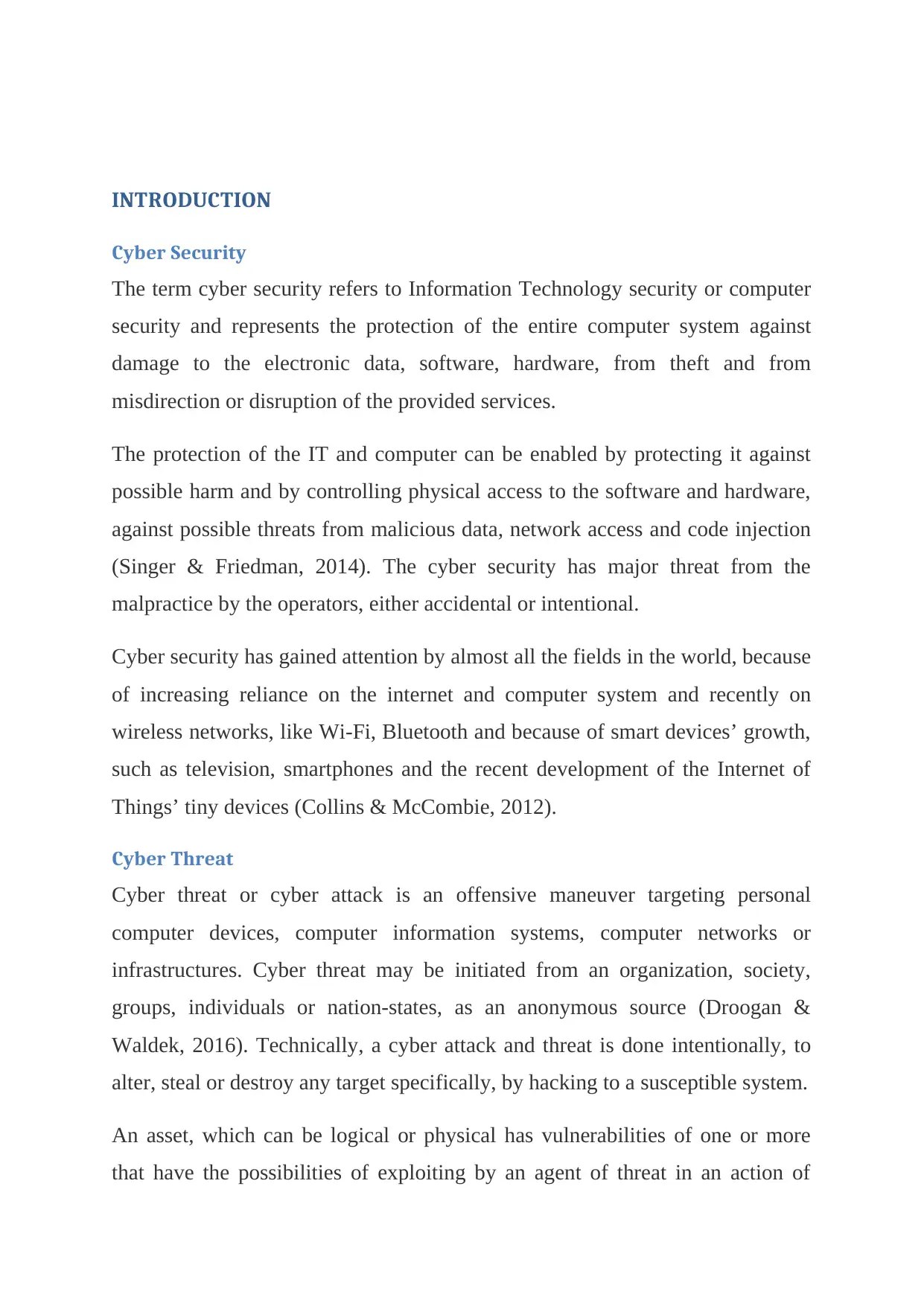
INTRODUCTION
Cyber Security
The term cyber security refers to Information Technology security or computer
security and represents the protection of the entire computer system against
damage to the electronic data, software, hardware, from theft and from
misdirection or disruption of the provided services.
The protection of the IT and computer can be enabled by protecting it against
possible harm and by controlling physical access to the software and hardware,
against possible threats from malicious data, network access and code injection
(Singer & Friedman, 2014). The cyber security has major threat from the
malpractice by the operators, either accidental or intentional.
Cyber security has gained attention by almost all the fields in the world, because
of increasing reliance on the internet and computer system and recently on
wireless networks, like Wi-Fi, Bluetooth and because of smart devices’ growth,
such as television, smartphones and the recent development of the Internet of
Things’ tiny devices (Collins & McCombie, 2012).
Cyber Threat
Cyber threat or cyber attack is an offensive maneuver targeting personal
computer devices, computer information systems, computer networks or
infrastructures. Cyber threat may be initiated from an organization, society,
groups, individuals or nation-states, as an anonymous source (Droogan &
Waldek, 2016). Technically, a cyber attack and threat is done intentionally, to
alter, steal or destroy any target specifically, by hacking to a susceptible system.
An asset, which can be logical or physical has vulnerabilities of one or more
that have the possibilities of exploiting by an agent of threat in an action of
Cyber Security
The term cyber security refers to Information Technology security or computer
security and represents the protection of the entire computer system against
damage to the electronic data, software, hardware, from theft and from
misdirection or disruption of the provided services.
The protection of the IT and computer can be enabled by protecting it against
possible harm and by controlling physical access to the software and hardware,
against possible threats from malicious data, network access and code injection
(Singer & Friedman, 2014). The cyber security has major threat from the
malpractice by the operators, either accidental or intentional.
Cyber security has gained attention by almost all the fields in the world, because
of increasing reliance on the internet and computer system and recently on
wireless networks, like Wi-Fi, Bluetooth and because of smart devices’ growth,
such as television, smartphones and the recent development of the Internet of
Things’ tiny devices (Collins & McCombie, 2012).
Cyber Threat
Cyber threat or cyber attack is an offensive maneuver targeting personal
computer devices, computer information systems, computer networks or
infrastructures. Cyber threat may be initiated from an organization, society,
groups, individuals or nation-states, as an anonymous source (Droogan &
Waldek, 2016). Technically, a cyber attack and threat is done intentionally, to
alter, steal or destroy any target specifically, by hacking to a susceptible system.
An asset, which can be logical or physical has vulnerabilities of one or more
that have the possibilities of exploiting by an agent of threat in an action of
⊘ This is a preview!⊘
Do you want full access?
Subscribe today to unlock all pages.

Trusted by 1+ million students worldwide
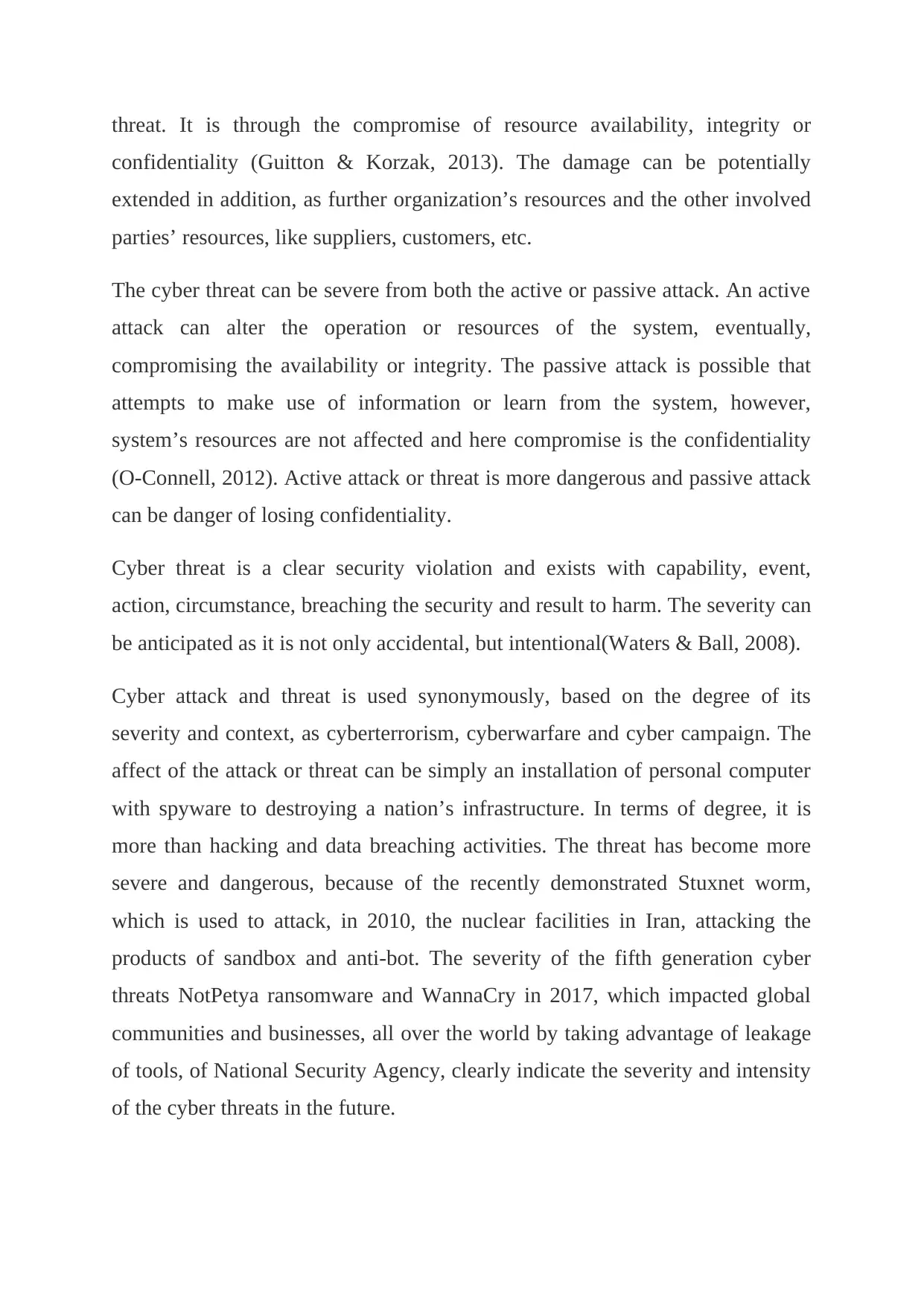
threat. It is through the compromise of resource availability, integrity or
confidentiality (Guitton & Korzak, 2013). The damage can be potentially
extended in addition, as further organization’s resources and the other involved
parties’ resources, like suppliers, customers, etc.
The cyber threat can be severe from both the active or passive attack. An active
attack can alter the operation or resources of the system, eventually,
compromising the availability or integrity. The passive attack is possible that
attempts to make use of information or learn from the system, however,
system’s resources are not affected and here compromise is the confidentiality
(O-Connell, 2012). Active attack or threat is more dangerous and passive attack
can be danger of losing confidentiality.
Cyber threat is a clear security violation and exists with capability, event,
action, circumstance, breaching the security and result to harm. The severity can
be anticipated as it is not only accidental, but intentional(Waters & Ball, 2008).
Cyber attack and threat is used synonymously, based on the degree of its
severity and context, as cyberterrorism, cyberwarfare and cyber campaign. The
affect of the attack or threat can be simply an installation of personal computer
with spyware to destroying a nation’s infrastructure. In terms of degree, it is
more than hacking and data breaching activities. The threat has become more
severe and dangerous, because of the recently demonstrated Stuxnet worm,
which is used to attack, in 2010, the nuclear facilities in Iran, attacking the
products of sandbox and anti-bot. The severity of the fifth generation cyber
threats NotPetya ransomware and WannaCry in 2017, which impacted global
communities and businesses, all over the world by taking advantage of leakage
of tools, of National Security Agency, clearly indicate the severity and intensity
of the cyber threats in the future.
confidentiality (Guitton & Korzak, 2013). The damage can be potentially
extended in addition, as further organization’s resources and the other involved
parties’ resources, like suppliers, customers, etc.
The cyber threat can be severe from both the active or passive attack. An active
attack can alter the operation or resources of the system, eventually,
compromising the availability or integrity. The passive attack is possible that
attempts to make use of information or learn from the system, however,
system’s resources are not affected and here compromise is the confidentiality
(O-Connell, 2012). Active attack or threat is more dangerous and passive attack
can be danger of losing confidentiality.
Cyber threat is a clear security violation and exists with capability, event,
action, circumstance, breaching the security and result to harm. The severity can
be anticipated as it is not only accidental, but intentional(Waters & Ball, 2008).
Cyber attack and threat is used synonymously, based on the degree of its
severity and context, as cyberterrorism, cyberwarfare and cyber campaign. The
affect of the attack or threat can be simply an installation of personal computer
with spyware to destroying a nation’s infrastructure. In terms of degree, it is
more than hacking and data breaching activities. The threat has become more
severe and dangerous, because of the recently demonstrated Stuxnet worm,
which is used to attack, in 2010, the nuclear facilities in Iran, attacking the
products of sandbox and anti-bot. The severity of the fifth generation cyber
threats NotPetya ransomware and WannaCry in 2017, which impacted global
communities and businesses, all over the world by taking advantage of leakage
of tools, of National Security Agency, clearly indicate the severity and intensity
of the cyber threats in the future.
Paraphrase This Document
Need a fresh take? Get an instant paraphrase of this document with our AI Paraphraser
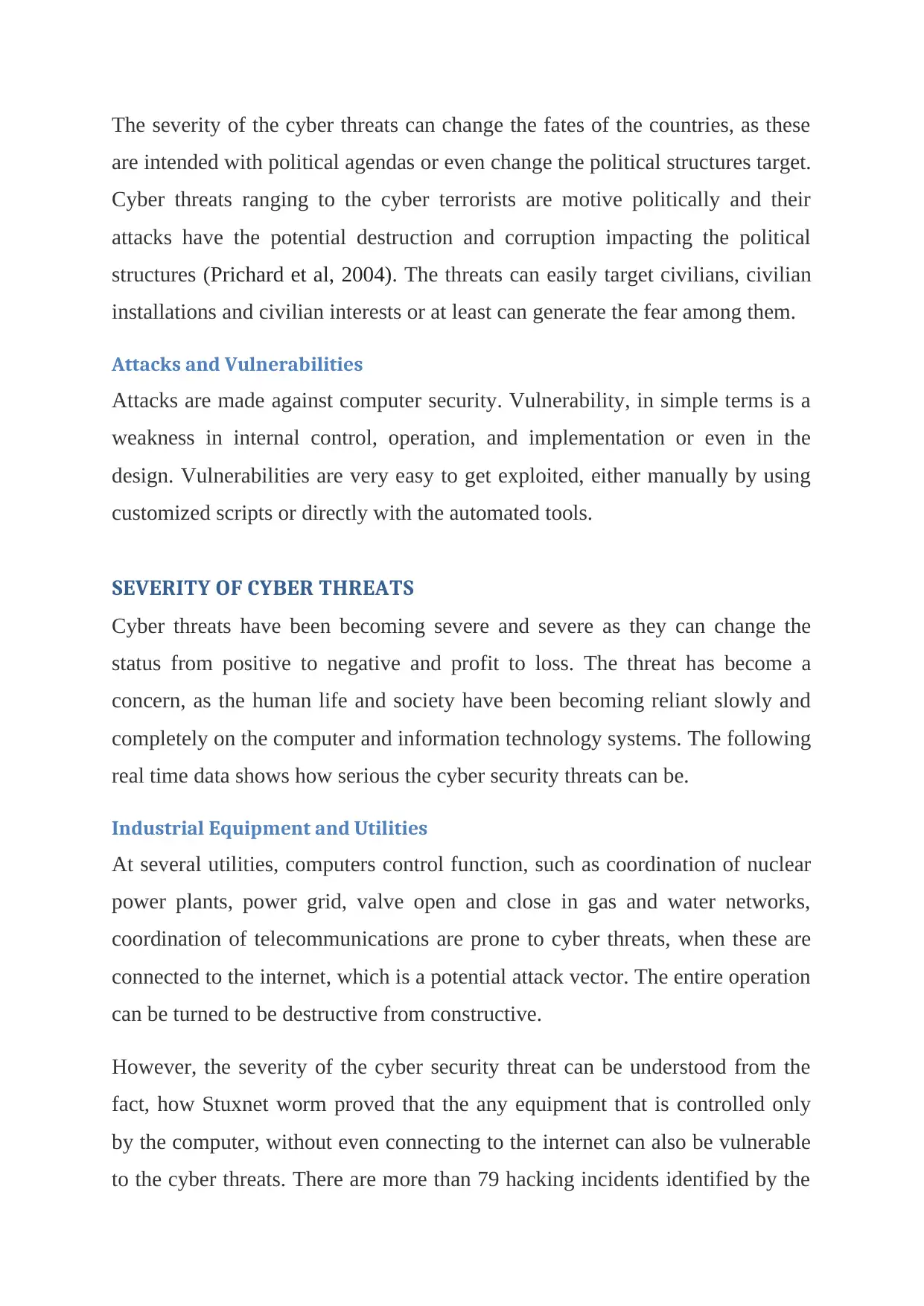
The severity of the cyber threats can change the fates of the countries, as these
are intended with political agendas or even change the political structures target.
Cyber threats ranging to the cyber terrorists are motive politically and their
attacks have the potential destruction and corruption impacting the political
structures (Prichard et al, 2004). The threats can easily target civilians, civilian
installations and civilian interests or at least can generate the fear among them.
Attacks and Vulnerabilities
Attacks are made against computer security. Vulnerability, in simple terms is a
weakness in internal control, operation, and implementation or even in the
design. Vulnerabilities are very easy to get exploited, either manually by using
customized scripts or directly with the automated tools.
SEVERITY OF CYBER THREATS
Cyber threats have been becoming severe and severe as they can change the
status from positive to negative and profit to loss. The threat has become a
concern, as the human life and society have been becoming reliant slowly and
completely on the computer and information technology systems. The following
real time data shows how serious the cyber security threats can be.
Industrial Equipment and Utilities
At several utilities, computers control function, such as coordination of nuclear
power plants, power grid, valve open and close in gas and water networks,
coordination of telecommunications are prone to cyber threats, when these are
connected to the internet, which is a potential attack vector. The entire operation
can be turned to be destructive from constructive.
However, the severity of the cyber security threat can be understood from the
fact, how Stuxnet worm proved that the any equipment that is controlled only
by the computer, without even connecting to the internet can also be vulnerable
to the cyber threats. There are more than 79 hacking incidents identified by the
are intended with political agendas or even change the political structures target.
Cyber threats ranging to the cyber terrorists are motive politically and their
attacks have the potential destruction and corruption impacting the political
structures (Prichard et al, 2004). The threats can easily target civilians, civilian
installations and civilian interests or at least can generate the fear among them.
Attacks and Vulnerabilities
Attacks are made against computer security. Vulnerability, in simple terms is a
weakness in internal control, operation, and implementation or even in the
design. Vulnerabilities are very easy to get exploited, either manually by using
customized scripts or directly with the automated tools.
SEVERITY OF CYBER THREATS
Cyber threats have been becoming severe and severe as they can change the
status from positive to negative and profit to loss. The threat has become a
concern, as the human life and society have been becoming reliant slowly and
completely on the computer and information technology systems. The following
real time data shows how serious the cyber security threats can be.
Industrial Equipment and Utilities
At several utilities, computers control function, such as coordination of nuclear
power plants, power grid, valve open and close in gas and water networks,
coordination of telecommunications are prone to cyber threats, when these are
connected to the internet, which is a potential attack vector. The entire operation
can be turned to be destructive from constructive.
However, the severity of the cyber security threat can be understood from the
fact, how Stuxnet worm proved that the any equipment that is controlled only
by the computer, without even connecting to the internet can also be vulnerable
to the cyber threats. There are more than 79 hacking incidents identified by the
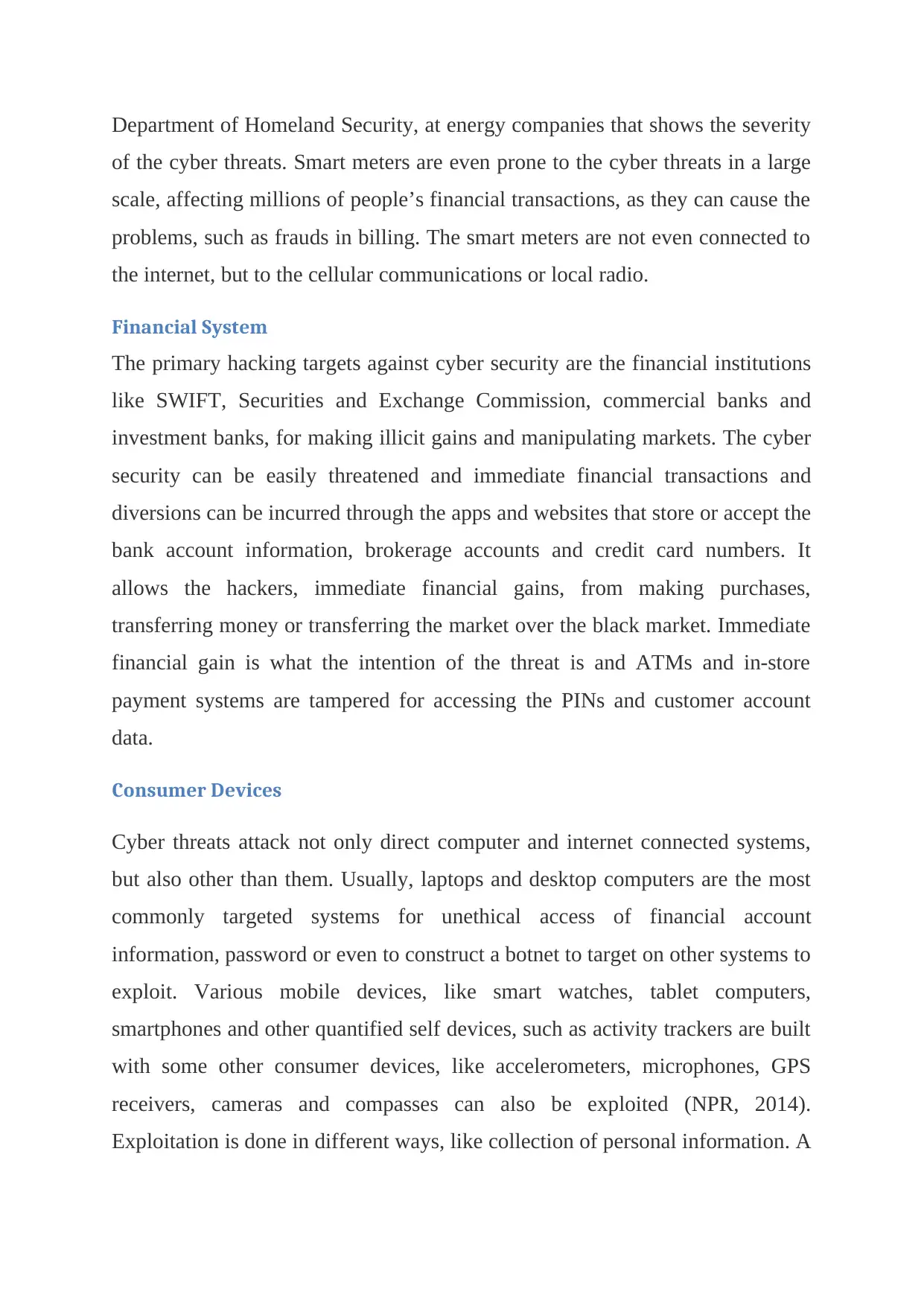
Department of Homeland Security, at energy companies that shows the severity
of the cyber threats. Smart meters are even prone to the cyber threats in a large
scale, affecting millions of people’s financial transactions, as they can cause the
problems, such as frauds in billing. The smart meters are not even connected to
the internet, but to the cellular communications or local radio.
Financial System
The primary hacking targets against cyber security are the financial institutions
like SWIFT, Securities and Exchange Commission, commercial banks and
investment banks, for making illicit gains and manipulating markets. The cyber
security can be easily threatened and immediate financial transactions and
diversions can be incurred through the apps and websites that store or accept the
bank account information, brokerage accounts and credit card numbers. It
allows the hackers, immediate financial gains, from making purchases,
transferring money or transferring the market over the black market. Immediate
financial gain is what the intention of the threat is and ATMs and in-store
payment systems are tampered for accessing the PINs and customer account
data.
Consumer Devices
Cyber threats attack not only direct computer and internet connected systems,
but also other than them. Usually, laptops and desktop computers are the most
commonly targeted systems for unethical access of financial account
information, password or even to construct a botnet to target on other systems to
exploit. Various mobile devices, like smart watches, tablet computers,
smartphones and other quantified self devices, such as activity trackers are built
with some other consumer devices, like accelerometers, microphones, GPS
receivers, cameras and compasses can also be exploited (NPR, 2014).
Exploitation is done in different ways, like collection of personal information. A
of the cyber threats. Smart meters are even prone to the cyber threats in a large
scale, affecting millions of people’s financial transactions, as they can cause the
problems, such as frauds in billing. The smart meters are not even connected to
the internet, but to the cellular communications or local radio.
Financial System
The primary hacking targets against cyber security are the financial institutions
like SWIFT, Securities and Exchange Commission, commercial banks and
investment banks, for making illicit gains and manipulating markets. The cyber
security can be easily threatened and immediate financial transactions and
diversions can be incurred through the apps and websites that store or accept the
bank account information, brokerage accounts and credit card numbers. It
allows the hackers, immediate financial gains, from making purchases,
transferring money or transferring the market over the black market. Immediate
financial gain is what the intention of the threat is and ATMs and in-store
payment systems are tampered for accessing the PINs and customer account
data.
Consumer Devices
Cyber threats attack not only direct computer and internet connected systems,
but also other than them. Usually, laptops and desktop computers are the most
commonly targeted systems for unethical access of financial account
information, password or even to construct a botnet to target on other systems to
exploit. Various mobile devices, like smart watches, tablet computers,
smartphones and other quantified self devices, such as activity trackers are built
with some other consumer devices, like accelerometers, microphones, GPS
receivers, cameras and compasses can also be exploited (NPR, 2014).
Exploitation is done in different ways, like collection of personal information. A
⊘ This is a preview!⊘
Do you want full access?
Subscribe today to unlock all pages.

Trusted by 1+ million students worldwide
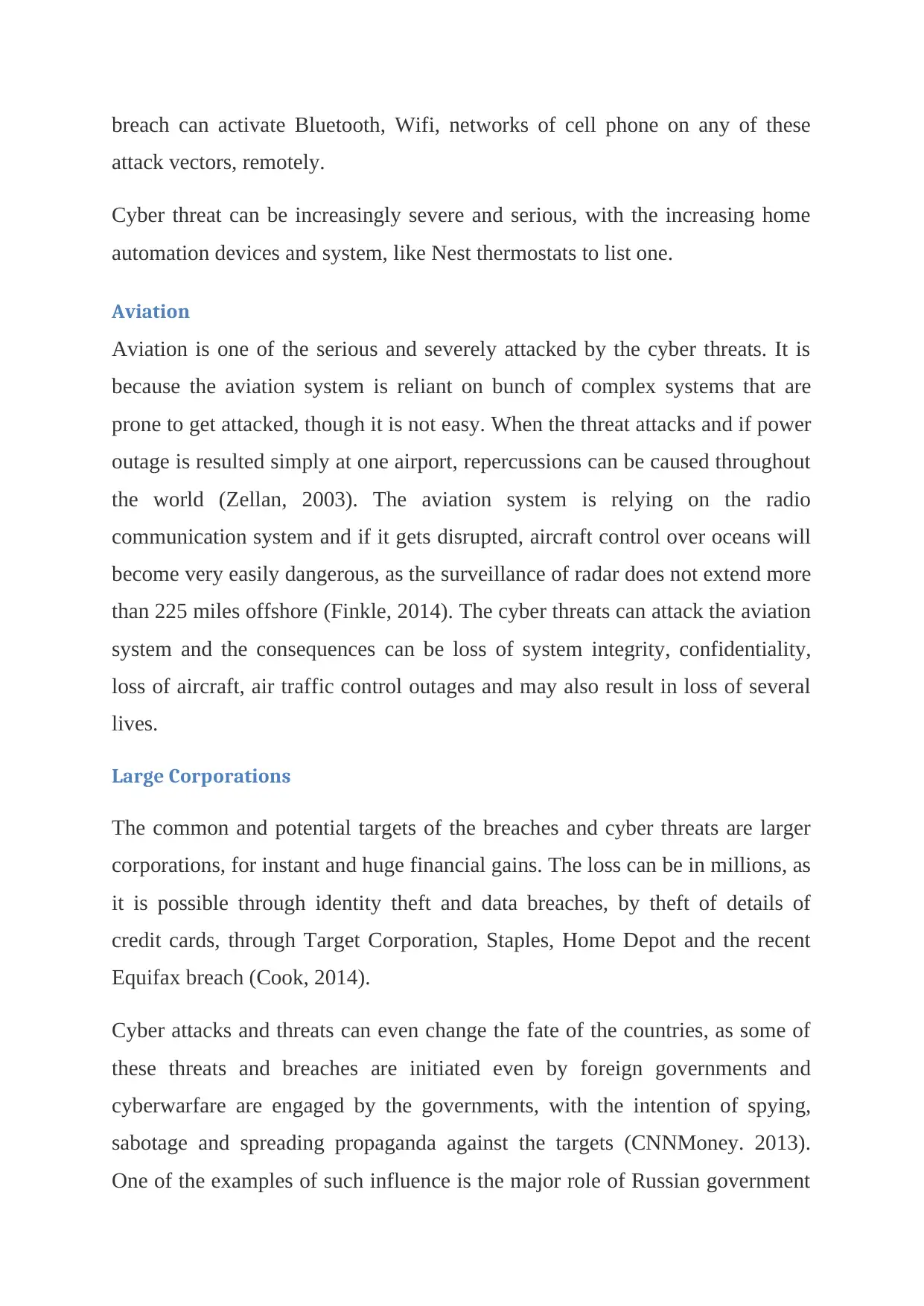
breach can activate Bluetooth, Wifi, networks of cell phone on any of these
attack vectors, remotely.
Cyber threat can be increasingly severe and serious, with the increasing home
automation devices and system, like Nest thermostats to list one.
Aviation
Aviation is one of the serious and severely attacked by the cyber threats. It is
because the aviation system is reliant on bunch of complex systems that are
prone to get attacked, though it is not easy. When the threat attacks and if power
outage is resulted simply at one airport, repercussions can be caused throughout
the world (Zellan, 2003). The aviation system is relying on the radio
communication system and if it gets disrupted, aircraft control over oceans will
become very easily dangerous, as the surveillance of radar does not extend more
than 225 miles offshore (Finkle, 2014). The cyber threats can attack the aviation
system and the consequences can be loss of system integrity, confidentiality,
loss of aircraft, air traffic control outages and may also result in loss of several
lives.
Large Corporations
The common and potential targets of the breaches and cyber threats are larger
corporations, for instant and huge financial gains. The loss can be in millions, as
it is possible through identity theft and data breaches, by theft of details of
credit cards, through Target Corporation, Staples, Home Depot and the recent
Equifax breach (Cook, 2014).
Cyber attacks and threats can even change the fate of the countries, as some of
these threats and breaches are initiated even by foreign governments and
cyberwarfare are engaged by the governments, with the intention of spying,
sabotage and spreading propaganda against the targets (CNNMoney. 2013).
One of the examples of such influence is the major role of Russian government
attack vectors, remotely.
Cyber threat can be increasingly severe and serious, with the increasing home
automation devices and system, like Nest thermostats to list one.
Aviation
Aviation is one of the serious and severely attacked by the cyber threats. It is
because the aviation system is reliant on bunch of complex systems that are
prone to get attacked, though it is not easy. When the threat attacks and if power
outage is resulted simply at one airport, repercussions can be caused throughout
the world (Zellan, 2003). The aviation system is relying on the radio
communication system and if it gets disrupted, aircraft control over oceans will
become very easily dangerous, as the surveillance of radar does not extend more
than 225 miles offshore (Finkle, 2014). The cyber threats can attack the aviation
system and the consequences can be loss of system integrity, confidentiality,
loss of aircraft, air traffic control outages and may also result in loss of several
lives.
Large Corporations
The common and potential targets of the breaches and cyber threats are larger
corporations, for instant and huge financial gains. The loss can be in millions, as
it is possible through identity theft and data breaches, by theft of details of
credit cards, through Target Corporation, Staples, Home Depot and the recent
Equifax breach (Cook, 2014).
Cyber attacks and threats can even change the fate of the countries, as some of
these threats and breaches are initiated even by foreign governments and
cyberwarfare are engaged by the governments, with the intention of spying,
sabotage and spreading propaganda against the targets (CNNMoney. 2013).
One of the examples of such influence is the major role of Russian government
Paraphrase This Document
Need a fresh take? Get an instant paraphrase of this document with our AI Paraphraser
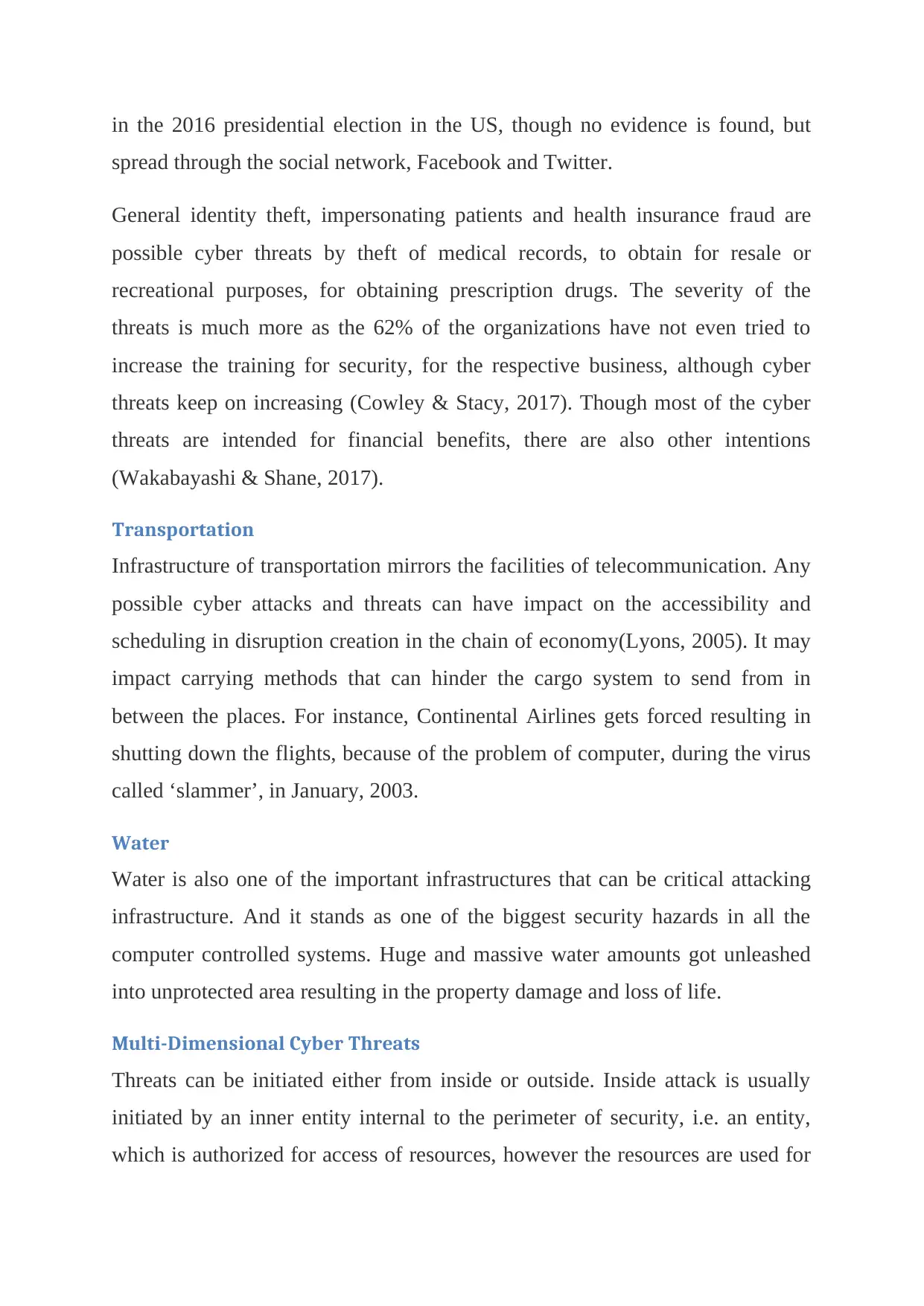
in the 2016 presidential election in the US, though no evidence is found, but
spread through the social network, Facebook and Twitter.
General identity theft, impersonating patients and health insurance fraud are
possible cyber threats by theft of medical records, to obtain for resale or
recreational purposes, for obtaining prescription drugs. The severity of the
threats is much more as the 62% of the organizations have not even tried to
increase the training for security, for the respective business, although cyber
threats keep on increasing (Cowley & Stacy, 2017). Though most of the cyber
threats are intended for financial benefits, there are also other intentions
(Wakabayashi & Shane, 2017).
Transportation
Infrastructure of transportation mirrors the facilities of telecommunication. Any
possible cyber attacks and threats can have impact on the accessibility and
scheduling in disruption creation in the chain of economy(Lyons, 2005). It may
impact carrying methods that can hinder the cargo system to send from in
between the places. For instance, Continental Airlines gets forced resulting in
shutting down the flights, because of the problem of computer, during the virus
called ‘slammer’, in January, 2003.
Water
Water is also one of the important infrastructures that can be critical attacking
infrastructure. And it stands as one of the biggest security hazards in all the
computer controlled systems. Huge and massive water amounts got unleashed
into unprotected area resulting in the property damage and loss of life.
Multi-Dimensional Cyber Threats
Threats can be initiated either from inside or outside. Inside attack is usually
initiated by an inner entity internal to the perimeter of security, i.e. an entity,
which is authorized for access of resources, however the resources are used for
spread through the social network, Facebook and Twitter.
General identity theft, impersonating patients and health insurance fraud are
possible cyber threats by theft of medical records, to obtain for resale or
recreational purposes, for obtaining prescription drugs. The severity of the
threats is much more as the 62% of the organizations have not even tried to
increase the training for security, for the respective business, although cyber
threats keep on increasing (Cowley & Stacy, 2017). Though most of the cyber
threats are intended for financial benefits, there are also other intentions
(Wakabayashi & Shane, 2017).
Transportation
Infrastructure of transportation mirrors the facilities of telecommunication. Any
possible cyber attacks and threats can have impact on the accessibility and
scheduling in disruption creation in the chain of economy(Lyons, 2005). It may
impact carrying methods that can hinder the cargo system to send from in
between the places. For instance, Continental Airlines gets forced resulting in
shutting down the flights, because of the problem of computer, during the virus
called ‘slammer’, in January, 2003.
Water
Water is also one of the important infrastructures that can be critical attacking
infrastructure. And it stands as one of the biggest security hazards in all the
computer controlled systems. Huge and massive water amounts got unleashed
into unprotected area resulting in the property damage and loss of life.
Multi-Dimensional Cyber Threats
Threats can be initiated either from inside or outside. Inside attack is usually
initiated by an inner entity internal to the perimeter of security, i.e. an entity,
which is authorized for access of resources, however the resources are used for
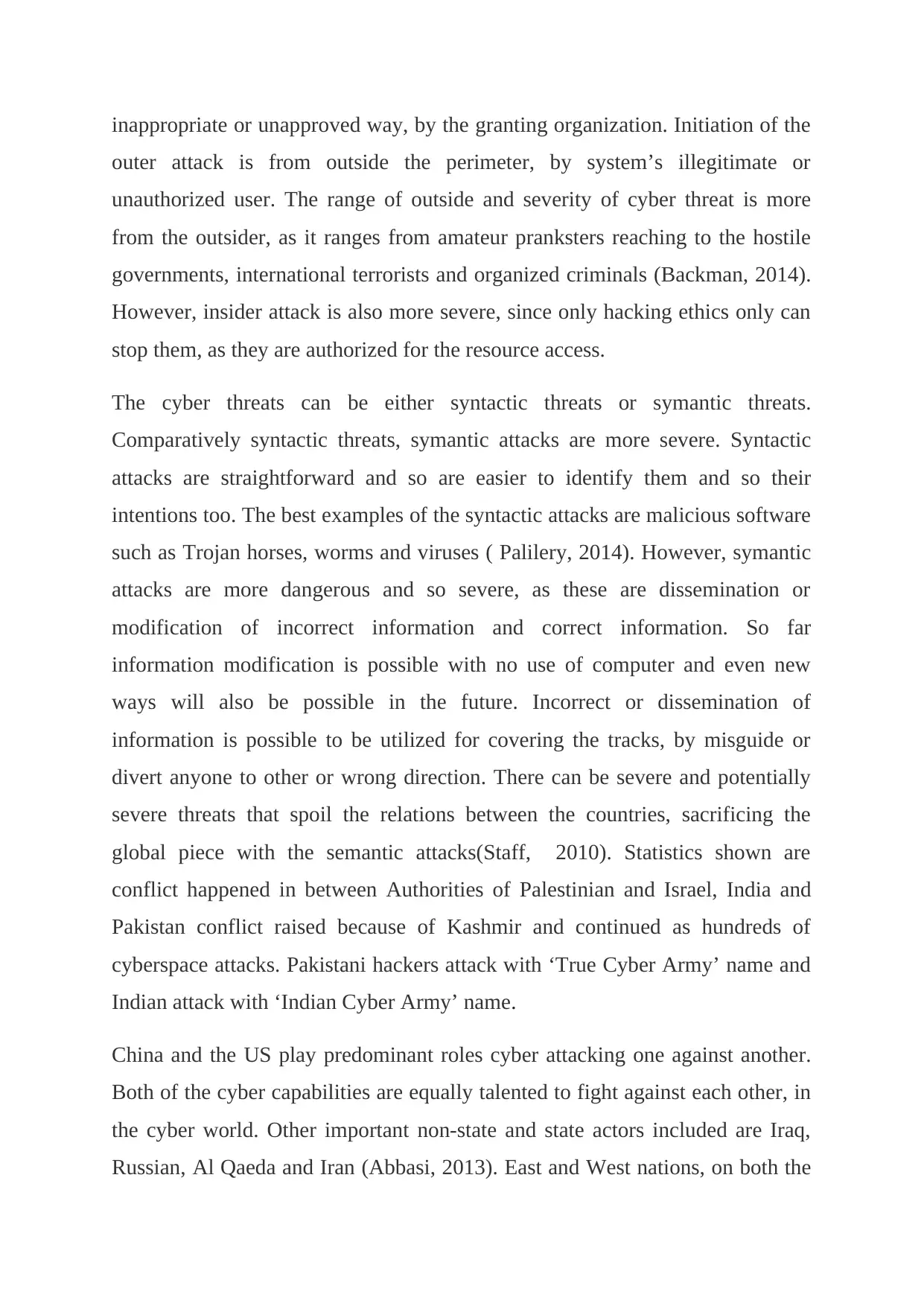
inappropriate or unapproved way, by the granting organization. Initiation of the
outer attack is from outside the perimeter, by system’s illegitimate or
unauthorized user. The range of outside and severity of cyber threat is more
from the outsider, as it ranges from amateur pranksters reaching to the hostile
governments, international terrorists and organized criminals (Backman, 2014).
However, insider attack is also more severe, since only hacking ethics only can
stop them, as they are authorized for the resource access.
The cyber threats can be either syntactic threats or symantic threats.
Comparatively syntactic threats, symantic attacks are more severe. Syntactic
attacks are straightforward and so are easier to identify them and so their
intentions too. The best examples of the syntactic attacks are malicious software
such as Trojan horses, worms and viruses ( Palilery, 2014). However, symantic
attacks are more dangerous and so severe, as these are dissemination or
modification of incorrect information and correct information. So far
information modification is possible with no use of computer and even new
ways will also be possible in the future. Incorrect or dissemination of
information is possible to be utilized for covering the tracks, by misguide or
divert anyone to other or wrong direction. There can be severe and potentially
severe threats that spoil the relations between the countries, sacrificing the
global piece with the semantic attacks(Staff, 2010). Statistics shown are
conflict happened in between Authorities of Palestinian and Israel, India and
Pakistan conflict raised because of Kashmir and continued as hundreds of
cyberspace attacks. Pakistani hackers attack with ‘True Cyber Army’ name and
Indian attack with ‘Indian Cyber Army’ name.
China and the US play predominant roles cyber attacking one against another.
Both of the cyber capabilities are equally talented to fight against each other, in
the cyber world. Other important non-state and state actors included are Iraq,
Russian, Al Qaeda and Iran (Abbasi, 2013). East and West nations, on both the
outer attack is from outside the perimeter, by system’s illegitimate or
unauthorized user. The range of outside and severity of cyber threat is more
from the outsider, as it ranges from amateur pranksters reaching to the hostile
governments, international terrorists and organized criminals (Backman, 2014).
However, insider attack is also more severe, since only hacking ethics only can
stop them, as they are authorized for the resource access.
The cyber threats can be either syntactic threats or symantic threats.
Comparatively syntactic threats, symantic attacks are more severe. Syntactic
attacks are straightforward and so are easier to identify them and so their
intentions too. The best examples of the syntactic attacks are malicious software
such as Trojan horses, worms and viruses ( Palilery, 2014). However, symantic
attacks are more dangerous and so severe, as these are dissemination or
modification of incorrect information and correct information. So far
information modification is possible with no use of computer and even new
ways will also be possible in the future. Incorrect or dissemination of
information is possible to be utilized for covering the tracks, by misguide or
divert anyone to other or wrong direction. There can be severe and potentially
severe threats that spoil the relations between the countries, sacrificing the
global piece with the semantic attacks(Staff, 2010). Statistics shown are
conflict happened in between Authorities of Palestinian and Israel, India and
Pakistan conflict raised because of Kashmir and continued as hundreds of
cyberspace attacks. Pakistani hackers attack with ‘True Cyber Army’ name and
Indian attack with ‘Indian Cyber Army’ name.
China and the US play predominant roles cyber attacking one against another.
Both of the cyber capabilities are equally talented to fight against each other, in
the cyber world. Other important non-state and state actors included are Iraq,
Russian, Al Qaeda and Iran (Abbasi, 2013). East and West nations, on both the
⊘ This is a preview!⊘
Do you want full access?
Subscribe today to unlock all pages.

Trusted by 1+ million students worldwide
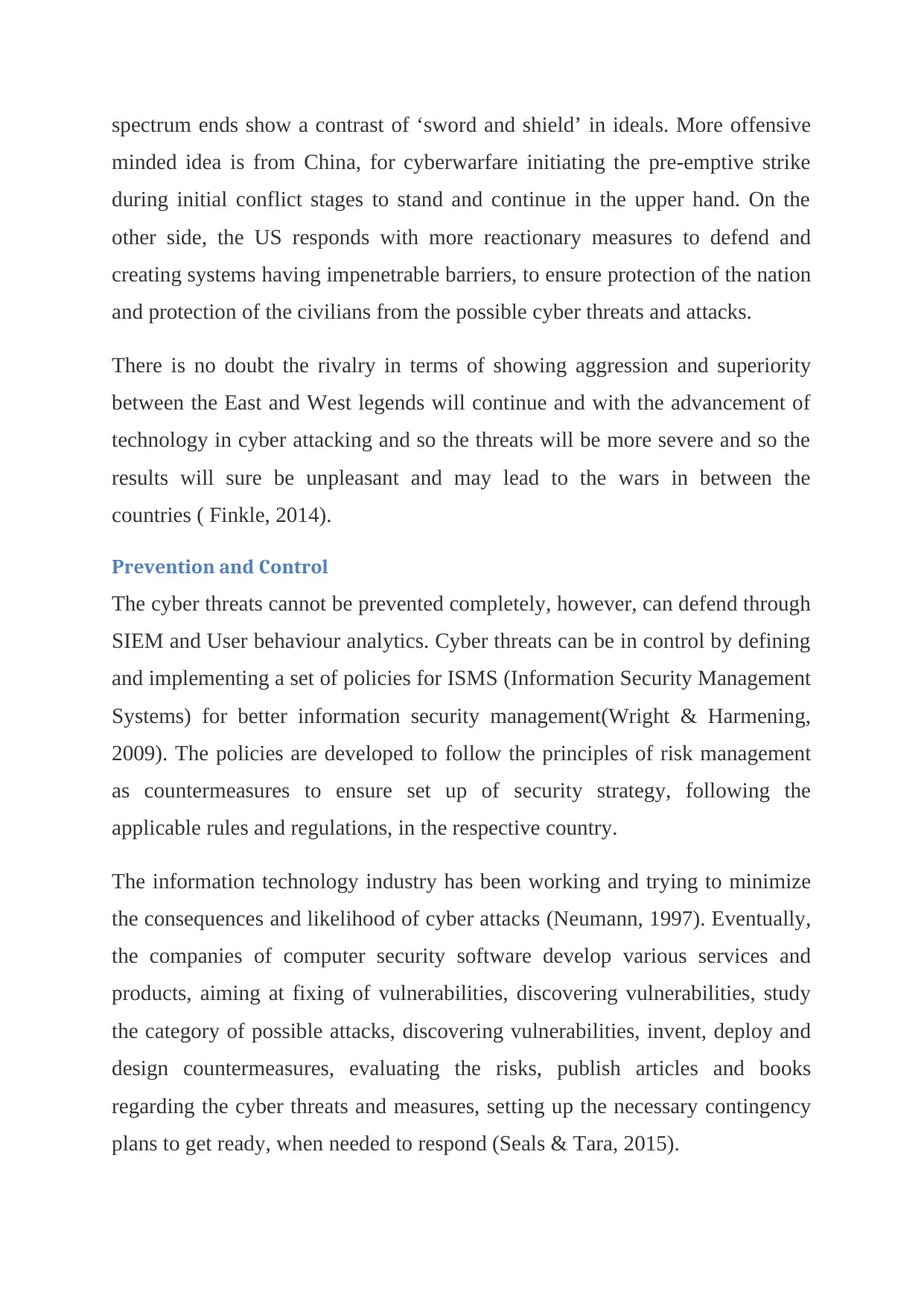
spectrum ends show a contrast of ‘sword and shield’ in ideals. More offensive
minded idea is from China, for cyberwarfare initiating the pre-emptive strike
during initial conflict stages to stand and continue in the upper hand. On the
other side, the US responds with more reactionary measures to defend and
creating systems having impenetrable barriers, to ensure protection of the nation
and protection of the civilians from the possible cyber threats and attacks.
There is no doubt the rivalry in terms of showing aggression and superiority
between the East and West legends will continue and with the advancement of
technology in cyber attacking and so the threats will be more severe and so the
results will sure be unpleasant and may lead to the wars in between the
countries ( Finkle, 2014).
Prevention and Control
The cyber threats cannot be prevented completely, however, can defend through
SIEM and User behaviour analytics. Cyber threats can be in control by defining
and implementing a set of policies for ISMS (Information Security Management
Systems) for better information security management(Wright & Harmening,
2009). The policies are developed to follow the principles of risk management
as countermeasures to ensure set up of security strategy, following the
applicable rules and regulations, in the respective country.
The information technology industry has been working and trying to minimize
the consequences and likelihood of cyber attacks (Neumann, 1997). Eventually,
the companies of computer security software develop various services and
products, aiming at fixing of vulnerabilities, discovering vulnerabilities, study
the category of possible attacks, discovering vulnerabilities, invent, deploy and
design countermeasures, evaluating the risks, publish articles and books
regarding the cyber threats and measures, setting up the necessary contingency
plans to get ready, when needed to respond (Seals & Tara, 2015).
minded idea is from China, for cyberwarfare initiating the pre-emptive strike
during initial conflict stages to stand and continue in the upper hand. On the
other side, the US responds with more reactionary measures to defend and
creating systems having impenetrable barriers, to ensure protection of the nation
and protection of the civilians from the possible cyber threats and attacks.
There is no doubt the rivalry in terms of showing aggression and superiority
between the East and West legends will continue and with the advancement of
technology in cyber attacking and so the threats will be more severe and so the
results will sure be unpleasant and may lead to the wars in between the
countries ( Finkle, 2014).
Prevention and Control
The cyber threats cannot be prevented completely, however, can defend through
SIEM and User behaviour analytics. Cyber threats can be in control by defining
and implementing a set of policies for ISMS (Information Security Management
Systems) for better information security management(Wright & Harmening,
2009). The policies are developed to follow the principles of risk management
as countermeasures to ensure set up of security strategy, following the
applicable rules and regulations, in the respective country.
The information technology industry has been working and trying to minimize
the consequences and likelihood of cyber attacks (Neumann, 1997). Eventually,
the companies of computer security software develop various services and
products, aiming at fixing of vulnerabilities, discovering vulnerabilities, study
the category of possible attacks, discovering vulnerabilities, invent, deploy and
design countermeasures, evaluating the risks, publish articles and books
regarding the cyber threats and measures, setting up the necessary contingency
plans to get ready, when needed to respond (Seals & Tara, 2015).
Paraphrase This Document
Need a fresh take? Get an instant paraphrase of this document with our AI Paraphraser
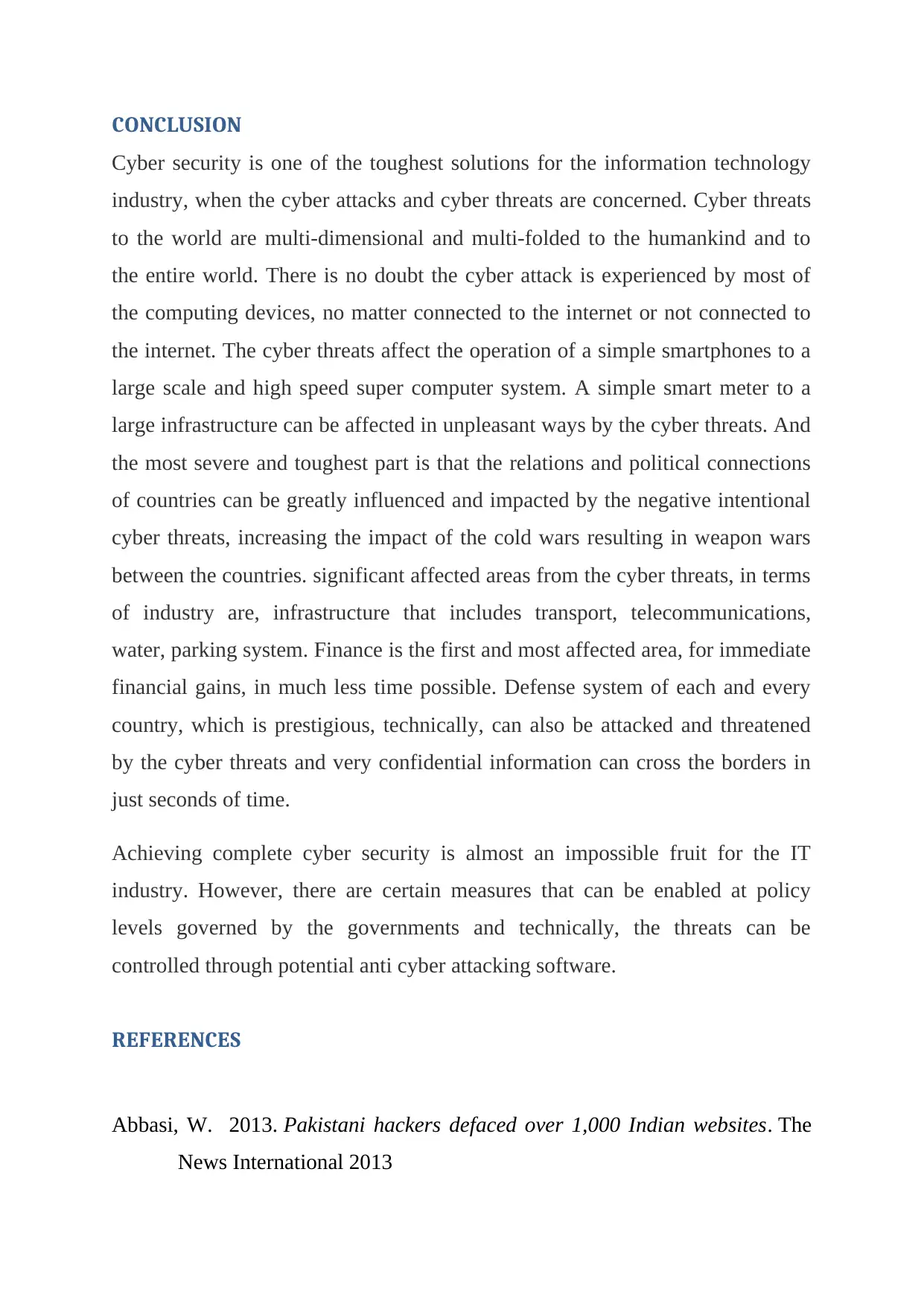
CONCLUSION
Cyber security is one of the toughest solutions for the information technology
industry, when the cyber attacks and cyber threats are concerned. Cyber threats
to the world are multi-dimensional and multi-folded to the humankind and to
the entire world. There is no doubt the cyber attack is experienced by most of
the computing devices, no matter connected to the internet or not connected to
the internet. The cyber threats affect the operation of a simple smartphones to a
large scale and high speed super computer system. A simple smart meter to a
large infrastructure can be affected in unpleasant ways by the cyber threats. And
the most severe and toughest part is that the relations and political connections
of countries can be greatly influenced and impacted by the negative intentional
cyber threats, increasing the impact of the cold wars resulting in weapon wars
between the countries. significant affected areas from the cyber threats, in terms
of industry are, infrastructure that includes transport, telecommunications,
water, parking system. Finance is the first and most affected area, for immediate
financial gains, in much less time possible. Defense system of each and every
country, which is prestigious, technically, can also be attacked and threatened
by the cyber threats and very confidential information can cross the borders in
just seconds of time.
Achieving complete cyber security is almost an impossible fruit for the IT
industry. However, there are certain measures that can be enabled at policy
levels governed by the governments and technically, the threats can be
controlled through potential anti cyber attacking software.
REFERENCES
Abbasi, W. 2013. Pakistani hackers defaced over 1,000 Indian websites. The
News International 2013
Cyber security is one of the toughest solutions for the information technology
industry, when the cyber attacks and cyber threats are concerned. Cyber threats
to the world are multi-dimensional and multi-folded to the humankind and to
the entire world. There is no doubt the cyber attack is experienced by most of
the computing devices, no matter connected to the internet or not connected to
the internet. The cyber threats affect the operation of a simple smartphones to a
large scale and high speed super computer system. A simple smart meter to a
large infrastructure can be affected in unpleasant ways by the cyber threats. And
the most severe and toughest part is that the relations and political connections
of countries can be greatly influenced and impacted by the negative intentional
cyber threats, increasing the impact of the cold wars resulting in weapon wars
between the countries. significant affected areas from the cyber threats, in terms
of industry are, infrastructure that includes transport, telecommunications,
water, parking system. Finance is the first and most affected area, for immediate
financial gains, in much less time possible. Defense system of each and every
country, which is prestigious, technically, can also be attacked and threatened
by the cyber threats and very confidential information can cross the borders in
just seconds of time.
Achieving complete cyber security is almost an impossible fruit for the IT
industry. However, there are certain measures that can be enabled at policy
levels governed by the governments and technically, the threats can be
controlled through potential anti cyber attacking software.
REFERENCES
Abbasi, W. 2013. Pakistani hackers defaced over 1,000 Indian websites. The
News International 2013
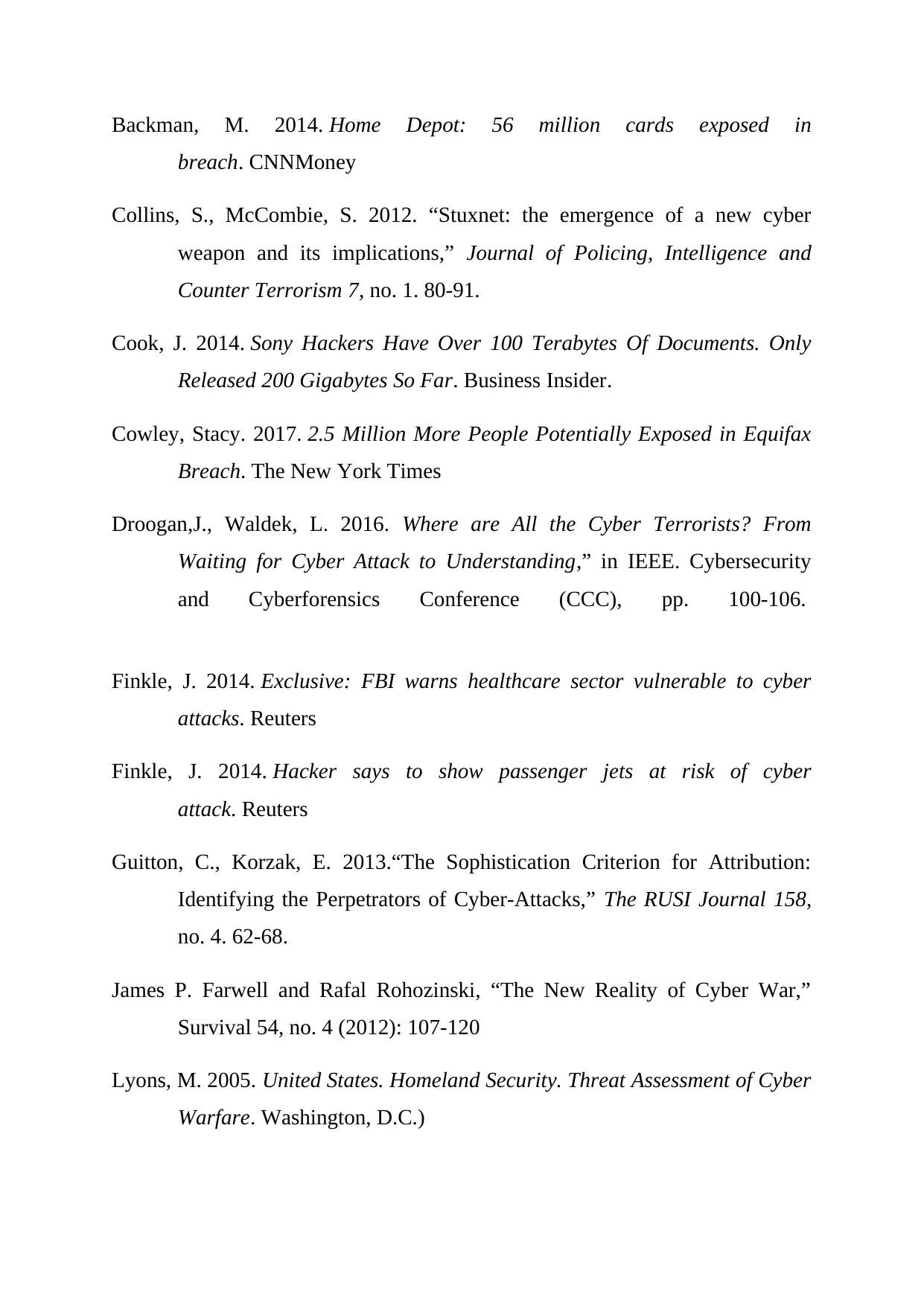
Backman, M. 2014. Home Depot: 56 million cards exposed in
breach. CNNMoney
Collins, S., McCombie, S. 2012. “Stuxnet: the emergence of a new cyber
weapon and its implications,” Journal of Policing, Intelligence and
Counter Terrorism 7, no. 1. 80-91.
Cook, J. 2014. Sony Hackers Have Over 100 Terabytes Of Documents. Only
Released 200 Gigabytes So Far. Business Insider.
Cowley, Stacy. 2017. 2.5 Million More People Potentially Exposed in Equifax
Breach. The New York Times
Droogan,J., Waldek, L. 2016. Where are All the Cyber Terrorists? From
Waiting for Cyber Attack to Understanding,” in IEEE. Cybersecurity
and Cyberforensics Conference (CCC), pp. 100-106.
Finkle, J. 2014. Exclusive: FBI warns healthcare sector vulnerable to cyber
attacks. Reuters
Finkle, J. 2014. Hacker says to show passenger jets at risk of cyber
attack. Reuters
Guitton, C., Korzak, E. 2013.“The Sophistication Criterion for Attribution:
Identifying the Perpetrators of Cyber-Attacks,” The RUSI Journal 158,
no. 4. 62-68.
James P. Farwell and Rafal Rohozinski, “The New Reality of Cyber War,”
Survival 54, no. 4 (2012): 107-120
Lyons, M. 2005. United States. Homeland Security. Threat Assessment of Cyber
Warfare. Washington, D.C.)
breach. CNNMoney
Collins, S., McCombie, S. 2012. “Stuxnet: the emergence of a new cyber
weapon and its implications,” Journal of Policing, Intelligence and
Counter Terrorism 7, no. 1. 80-91.
Cook, J. 2014. Sony Hackers Have Over 100 Terabytes Of Documents. Only
Released 200 Gigabytes So Far. Business Insider.
Cowley, Stacy. 2017. 2.5 Million More People Potentially Exposed in Equifax
Breach. The New York Times
Droogan,J., Waldek, L. 2016. Where are All the Cyber Terrorists? From
Waiting for Cyber Attack to Understanding,” in IEEE. Cybersecurity
and Cyberforensics Conference (CCC), pp. 100-106.
Finkle, J. 2014. Exclusive: FBI warns healthcare sector vulnerable to cyber
attacks. Reuters
Finkle, J. 2014. Hacker says to show passenger jets at risk of cyber
attack. Reuters
Guitton, C., Korzak, E. 2013.“The Sophistication Criterion for Attribution:
Identifying the Perpetrators of Cyber-Attacks,” The RUSI Journal 158,
no. 4. 62-68.
James P. Farwell and Rafal Rohozinski, “The New Reality of Cyber War,”
Survival 54, no. 4 (2012): 107-120
Lyons, M. 2005. United States. Homeland Security. Threat Assessment of Cyber
Warfare. Washington, D.C.)
⊘ This is a preview!⊘
Do you want full access?
Subscribe today to unlock all pages.

Trusted by 1+ million students worldwide
1 out of 13
Related Documents
Your All-in-One AI-Powered Toolkit for Academic Success.
+13062052269
info@desklib.com
Available 24*7 on WhatsApp / Email
![[object Object]](/_next/static/media/star-bottom.7253800d.svg)
Unlock your academic potential
Copyright © 2020–2025 A2Z Services. All Rights Reserved. Developed and managed by ZUCOL.





